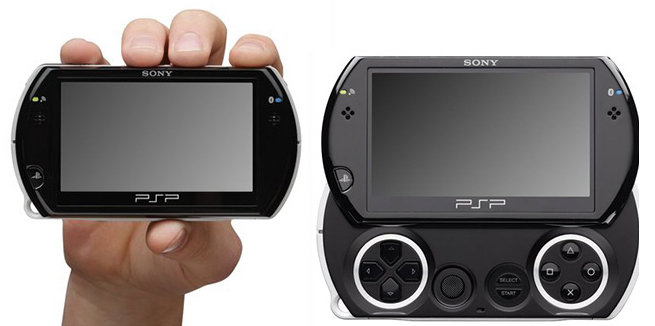Cool but Ultimately Pointless this week focuses on Sony’s latest effort to corner the market in hand-held computer gaming, the PSP Go.

[History lesson - feel free to skip] Sony launched the original PlayStation Portable system back in 2005, the first hand-held video game console to use an optical disc format, Universal Media Disc (UMD), as its primary storage medium. With 1.8Gb of storage, Sony intended this medium to herald a new wave of mobile media. But the format’s proprietary nature and the lack of writers and blank media meant that film studios and content providers shied away from it. Despite the relative failure of its storage medium the PSP sold well worldwide but continually lagged behind its main competitor, the Nintendo DS. Sony has constantly strived to increase it’s market-share in hand-held gaming and with the launch of the PSP Slim & Lite in 2007 sales increased dramatically. This newer platform was 33% lighter and 19% slimmer than the original PSP system and it’s on-board RAM was doubled to help increase loading times for games. The 3rd generation PSP came along in 2008 and introduced an on-board microphone and enhanced screen. The 3rd generation has not fared as well in sales however and has had notably issues with the new screen. [/History lesson]
The PSP Go marks a dramatic change in direction for Sony in regards to the PSP series. Gone is the UMD drive and in comes 16GB of internal memory. This means that games can only be downloaded from the PlayStation Store, using the built-in wi-fi or via PC or PS3, making it the first download-only PSP. The main reasoning behind this is likely the success of Apple’s iPhone and iPod touch, but it has alienated retailers. Retailers make most of their money from the games rather than the consoles and while Sony insist that there is a high mark-up built into the system price, retailers are set to lose out on repeat business. Nedgame, a gaming speciality store in the Netherlands, won’t be selling the PSP Go at all. Rumours have risen that EBGames are refusing to stock the hardware in Australia, and some Spanish retailers have considered not stocking the system.
For those existing owners of PSP systems who may be considering an upgrade to the PSP Go, the lack of a UMD drive prevents you from playing all of your old UMD-based games, while all saved files will have to be manually moved to the new system since the Memory Stick Pro Duo is not compatible with the new device. Despite early rumors there is no trade-in program or method for transferring existing UMD games to the PSP Go, meaning that you will have to repurchase old games from the PlayStation Store if you wish to play them on the Go. Also existing peripherals and accessories for the PSP are not compatible with the Go unless you purchase the Sony PSP Go Converter Cable Adapter which turns your beautiful new sleek PSP into a hideous monstrosity (see above). Oh and it won’t be available until after Christmas.
As if the lack of support for old games and accessories wasn’t bad enough Sony expects customers to pay €250 for the new system. To put that into perspective that’s €50 less that the Blu-ray supporting PS3 and the rival X-Box 360 Elite, €50 more expensive than a Nintendo Wii and €90 more expensive than the PSP’s main competition, the Nintendo DSi. It’s also more than €50 more expensive than the current PSP, which will benefit from all the new downloadable games and content from the PlayStation Store as the Go. Add to that Sony’s publicly stated intention to maintain a “pricing parity” with the recommended retail price for its digital downloads which means that games sold in stores on UMD will often undercut the PlayStation Store’s pricing.
There are some positives about the PSP Go. It’s smaller, lighter and easier to carry than the current PSP, plus you don’t have to carry around loads of discs to change games. The new screen, whilst smaller at 3.8in compared to the current 4.3in, is reportedly sharper and brighter. The new system has a slide-out set of controls which are meant to be more tactile and robust. Games will load much faster from the internal memory than from the UMDs. The PSP Go also adds Bluetooth 3.0 connectivity, which should make it easy to connect wireless headsets.
None of the positives can make up for the price hike and lack of legacy support, and in this current economic climate that makes the PSP Go Cool but Ultimately Pointless compared to the current PSP.







No UMD? That is a kick in the teeth to all those who bought those ridiculous UMD movies, never mind the games themselves.
I’m guessing Sony are trying to combat all the PSP piracy with this one, but it’ll probably be hacked within a week.
Oh, are you getting one?
I won’t be getting one unless Sony wants to give me a free one. [holds breath...]
Pingback: A little bit of Culchure «